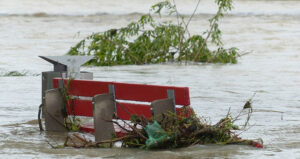New maps double flood risks of Spanish homes

-
 Editorial Team
Editorial Team
Share article:
Updated flood risk maps in Spain double the number of homes currently located in flood-prone areas to nearly 2 million, representing no less than 7.9% of the country’s housing stock. The new data are the result of calculations published by the Spanish newspaper El Diario, based on information from Land Registry (Catastro) and the National Flood Zone Mapping System (SNCZI).
The updated maps from elDiario.es still consider the region with the highest percentage of homes at risk of flooding remains Murcia, with 26.9% of its properties affected. This region is followed by Asturias (14.3%), Cantabria (12.9%), and the Basque Country (12.6%). Among major cities, Seville has the highest risk, with 50.5% of its homes in danger.
Construction in unsafe areas fueled by real estate bubble
In recent decades, hundreds of thousands of homes have been built in flood risk areas. Between 1997 and 2008, during Spain’s real estate bubble, 464,000 homes were constructed in areas at risk of flooding. According to the newspaper warns the amount of homes in flood risk areas may even be higher, because the updated maps only address riverine and coastal flooding. Floodings caused by rainfall accumulation on terrain unable to drain it, such as in urban underpasses, are excluded.
Improve flood prevention
Experts, including hydraulic engineers, meteorologists, geographers, and geologists, emphasize the importance of increasing flood prevention in the face of climate emergency threats, even in zones considered ‘exceptional’ with a 500-year return period, equating to a 0.2% annual risk. Some experts question the validity of return periods (10, 50, 100, or 500 years) as a primary risk calculation tool in a changing climate. Jorge Olcina, a geography professor and director of the Climatology Laboratory at the University of Alicante, warns that these measures are becoming less reliable, especially in the Mediterranean, as extreme events become more frequent. Ernest Bladé, director of the Flumen Institute at the Polytechnic University of Catalonia, highlights the challenges of incorporating climate variability into risk models.
More DANA’s expected
Meteorologists agree there is no clear evidence that violent phenomena like DANAs (isolated high-altitude depressions) will become more frequent, but their intensity is expected to increase. María del Carmen Llasat, a professor of Atmospheric Physics at the University of Barcelona, advises that even those in low-risk zones should prepare for intense rainfall events. In October 2024 Valencia was hit by disastrous floodings. This event has raised flood awareness in Spain.
Updating flood risk classifications
Spain’s hydraulic regulations and regional laws impose restrictions on construction in flood zones, particularly in Preferred Flow Areas. These zones require elevated construction levels and limit essential infrastructure like hospitals and schools. However, enforcement has been inconsistent. The government is now working on its third flood risk evaluation cycle according to the European Floods Directive, aiming to update and expand flood zone classifications. Preliminary studies will be open for public consultation in July 2025.

















